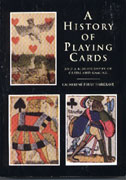
A History of Playing Cards

Playing Cards
Poker Talk; History Of Playing Cards Should Enlighten And Entertain Players
It’s inevitable. It happens every time there’s a surge of interested in one topic or another. For us it’s poker. As the numbers of poker players proliferate many who belong to the Howard Schwartz, the "librarian for gamblers," is the marketing director for Gambler's Book Club in Las Vegas, a position he has held since 1979. Author of hundreds of articles on gambling, his weekly book reviews appear in numerous publications throughout the gaming industry. Howard's website is www.gamblersbook.com newer generation of action-seekers will have an information gap of sorts. They’re bound to have questions involving the derivation of certain poker terms and questions about the origins of playing cards. Simply, sometimes we play games without knowing how it evolved into its present form or we have questions and don't know where to go for answers.
Howard Schwartz, the "librarian for gamblers," is the marketing director for Gambler's Book Club in Las Vegas, a position he has held since 1979. Author of hundreds of articles on gambling, his weekly book reviews appear in numerous publications throughout the gaming industry. Howard's website is www.gamblersbook.com newer generation of action-seekers will have an information gap of sorts. They’re bound to have questions involving the derivation of certain poker terms and questions about the origins of playing cards. Simply, sometimes we play games without knowing how it evolved into its present form or we have questions and don't know where to go for answers.
Two new books and one old classic make help.
They are Poker Talk (How to Talk Poker Like a Pro!) by Avery Cardoza (303 pages, paperbound, $9.95); Playing Cards by Ira Pearlstein and Buzz Poole (127 pages, hardbound, $24.95) and A History of Playing Cards by Catherine Perry Hargrave (462 pages, paperbound, $19.95) and they should do the trick.
Cardoza's Poker Talk is probably most valuable for players and dealers, to help explain what terms like ‘implied odds’; ‘shoot at a player’; or a ‘Baskin-Robbins’ mean.
When novice players feel uncomfortable at the table, they're apt not to return to a card room or a particular game if players around them are using slang or jargon which puzzle or confuse them. A smart dealer seeking appropriate tokes will clarify these slang expressions for a player who seems puzzled or asks--either during or after a game.
Inquisitive players seeking to gain confidence will buy a book so opponents don't wind up talking around them so to speak.
The thousands or terms and phrases are in alphabetical order, with clarifying examples and occasional cartoons where the usage is illuminated or emphasized.
It's a handy little book--a nice gift item for players, dealers or for those running a card room or occasional tournament.
Playing Cards is a highly unusual book in that its format is almost a foot wide and only five inches deep, sure to attract attention on any coffee table or bookshelf.
It's a book sure to appeal to those not only interested in the history of playing cards, but their design and the influence of Art Deco from the 1930s to the 1940s in particular.
The book as the compilers so aptly put it ‘provides a window through which the American scene of the time can be examined. In terms of design and subject matter, the cards contained with speak to a bygone era through a medium still present today...’
Collectors, graphic arts specialists, those fascinated with quirky card designs; historians too will find joy in this book, which includes a fascinating analysis of the various types of jokers many of the decks contained.
Hargrave's A History of Playing Cards was originally published in 1930. An original may sell for $700 or higher depending on condition, in part because it contains many full color pictures of the playing cards. In this edition, published in 2000, those color pictures are in black and white.
In more than a dozen chapters, the author traces the history of playing cards in Asia, Europe and the United States, with analysis, theories and examples of how each nation, each century influenced another as gambling, recreational play and technology each impacted the other.
A super resource for historians, collectors or for the intellectually curious who look to the past for an idea of what the future will hold in regard to playing cards and their design.

